|
Last year I became an apartment dweller after 25 years of living in the country. I changed jobs and the boss decreed that I live in town, so I packed the truck and moved in with my lady, who lives in town. I still have my place in the country and go there regularly to check on my adult children, do a little shooting, and keep track of the neighbors.
The one thing I missed was tinkering around on my loading bench, which was set up in my bedroom. It looked out a window over my personal shooting range and I was blessed there by being able to load five cartridges, then walking ten steps and shooting them. For a shooter, a place in the country is wonderful.
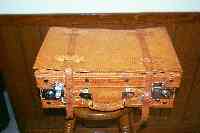
A complete reloading kit fits in this attache case.
|
I found a range in town, close to the apartment, and I can get out there when necessary to burn powder. But reloading in the apartment was a problem. My reloading bench just didn't fit in with the decor. I determined that I would put together a small, portable loading outfit that I could store in a closet, or under a bed. It was easier than I expected. The basis of the outfit is the Lee Hand Press. This little red press is designed to allow loading wherever the shooter happens to be.
I carry a revolver every working day and I like to shoot it to keep my skill at a respectable level. Reloading makes sense for me. I load practice ammo to keep down costs. While I have complete confidence in my reloads, for a variety of legal and liability reasons I carry factory ammo while on duty.
I like equipment manufactured by Lee Precision. The good folks at Lee stand behind their products and give exceptional value for the money. I've been using their products for twenty years, and I don't see a reason to change. The other companies all manufacture quality reloading tools, and a lot of people like them. That's great. Competition drives our economy and keeps prices where everyone can afford to reload.
Here are the costs associated with my reloading outfit. All prices are as currently available in my local area or on the Internet.
| Lee Hand Press | $17.97 |
| Lee .38 Special Dies | $21.21 |
| 1 lb powder | $23.86 |
| Lead bullets (300) | $10.90 |
| Primers (100) | $2.95 |
| Priming Tool | $8.99 |
| Loading block | $6.42 |
| Total | $92.30 |
The table doesn't show the cost for brass. I don't buy brass. Because I carry factory ammo in my duty handgun, I shoot a couple of boxes a year to keep my ammo fresh. I save my brass and that is what I reload. If you buy brass, your per shot cost will be a little higher. While we are talking about costs, let's look at the per shot cost of my handloaded ammo.
| Component | per shot cost | per box (50) cost |
| Brass | .00 | .00 |
| Powder | .01985 | .99 |
| Bullet | .03633 | $1.82 |
| Primer | .0295 | $1.48 |
| Total | .0858 | $4.29 |
We can see that reloading ammunition saves money. Factory ammo costs me between $10.00 and $15.00 per box. My handloads cost me under $5.00 per box. It makes sense to handload if you shoot more than ten or fifteen boxes of ammo per year. You can get started reloading for under $100.00, which translates into about ten boxes of ammo per year. Most of what you buy for your hundred dollars is equipment, so the costs of ammo go down every time you load a box. The equipment is sturdy and will last your lifetime. Your children will use it long after you are gone.
So, let's get started handloading. What should we do first? I would gather the tools and load data. Don't buy components until you are sure what type ammo you want to reload. The major powder companies will give you load data, and it is available over the Internet. Lee dies come with reloading data. Follow the load data exactly. I like to call them recipes. They must be followed exactly to insure safety. Handloading ammunition is no more dangerous than driving a car, but attention must be paid to detail. Manuals are available from the equipment companies, and I have two: Lee's Modern Reloading and The Lyman Cast Bullet Handbook. I use one manual to double-check the other one for safe handload recipes. I load conservatively to keep pressure and velocity at acceptable levels.
Over the years I have come upon some loads that consistently offer me good power, velocity and accuracy. I am not going to discuss them here. Each person who reloads should depend on published load data until they are experienced enough to know the warning signs of excessive pressure, and how mixing components can affect ammunition performance.
Once you have decided what you want to reload, buy the equipment and components. One word of caution. Find a local gunshop where you can buy powder and primers. These two components are hazardous and the shipping companies charge extra fees for handling them. The small quantities you will need will be prohibitively expensive if you try to buy them on-line. Your local gunshop stocks what you need, and your business helps keep him open to serve you. Buy powder and primers from a local merchant and help keep the economy rolling.
The first step is case preparation. Here we inspect the brass case for splits, cracks, or any damage and determine if the case is okay to load, or if it should be discarded. Discard any brass that looks damaged. Remember that the brass will withstand pressures well above 10,000 psi. Use only good brass. Clean all dirt and grit from your brass.

Inspect your brass thoroughly before you prime.
|
Next, we deprime and size the brass. I use a carbide sizing die which doesn't require case lubrication. Brass expands under firing, and we have to resize it. Snap the shell holder into place, then install the resizing die into press until it contacts the shellholder. Then open the press and turn the die in an additional half-turn. Insert the brass into the shellholder then close the press. The die resizes the brass case and the decapping pin pushes out the primer.
It's not absolutely necessary to clean the primer pocket for every reloading. To clean it, use one of the little tools available from Lee and several others. Or simply run the point of a nail around the inside edge of the pocket and then blow out the debris.
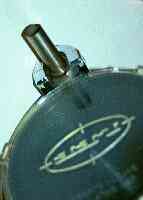
Priming the brass, use consistent pressure and feel the primer when it enters the pocket. |
The next step is to insert another primer. I use the Lee Auto Prime, because it gives me the best feel when the primer is seated. I can actually feel the primer slip into the primer pocket on the base of the cartridge. This tool lets me sit in front of the TV and put primers into brass for reloading later. I usually keep a box or so of empty, primed brass in the event I want to do some quick loading without the steps of inspecting, depriming, and resizing brass cases.
Caution: wear safety glasses and point the case mouth away from your face.
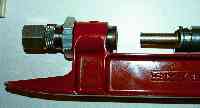
Look closely at the end of the brass to see the expansion. This is plenty. Some experienced reloaders would say it is too much. |
Next, we want to expand the brass. The case has been resized and we have to expand the brass so that it will accept the bullet. The die that bells the case is adjustable, and you have to try it on a few cases to get the amount of expansion that works best for you. I prefer to bell my brass so that I can insert a bullet about half-way with my thumb.
The powder comes next, and here we need to discuss powder measurement. There are two ways to measure powder, by volume and by weight. A pound of powder contains 7000 grains, and load data is discussed in grains. (Note: 1 grain is the average weight of 1 healthy grain of wheat.)
Powder measures dispense powder by volume, because we know that a certain volume of powder contains a certain grain weight. All powder types vary by density, so each charge of powder should be carefully calibrated. By using good reloading practices, with careful attention to detail, there is no need to weigh each powder charge. Many reloaders do weigh each charge, but I have convinced myself that loading by volume is both safe and effective. I weigh charges occasionally, more to double-check myself than anything else.
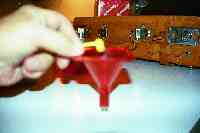
Charging the case with a Lee dipper.
|
This picture shows me using a Lee Dipper to charge a case. After carefully checking my data, I know that this volume of powder constitutes a safe, low pressure load in combination with the bullet and primer I am using. The case is under the funnel.

The bullet in the case with thumb pressure.
|
This shot shows the case with the bullet in the case under thumb pressure. I do this immediately after I load the powder as a safety measure. With the bullet in the case, I cannot insert any more powder, and I know which cases I have worked with. Inserting the bullet immediately gives me good visual knowledge and prevents double-charging a case.
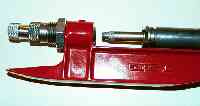
Seating the bullet.
|
The next step is seating the bullet and crimping it into the case. The bullet must be seated to a point where the overall length of the cartridge will function in the gun. Cartridges that are too long just won't work. Adjusting the die is fairly easy, and most dies come with complete instructions. This die crimps the case once the bullet is seated. The crimping reduces the expansion we put in the case before we loaded the powder.
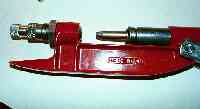
Finished. We have reloaded one round of ammunition. |
Crimp (or the lack of it) is important depending on what type of cartridge we are loading. This cartridge is for a revolver, and I have installed a medium crimp. I want the bullet held firmly in place, and the design of the cartridge is such that it headspaces on the rim. Autoloader ammunition headspaces on the mouth of the cartridge and we use a mimimal crimp on those cartridges. Again, the available literature will help you determine the amount of crimp you need on your ammunition.
This completes the cartridge. We started with an empty brass case and have assembled a complete round of ammunition.
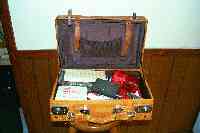
My personal ammo factory. |
Reloading ammo doesn't require a great deal of equipment, and there is no reason why an apartment dweller can't have a compact, easily stored reloading kit. My kit fits in a leather attache that was thrown away by a friend. It measures 17" x 11.5" x 6.5" and normally sits unobtrusively next to the couch. Friends don't know what it is, unless they ask. The grandkids can't lift it, yet, and only my lady and myself know that it contains my personal ammunition factory.
Copyright 2003 by Dennis Dezendorf
|